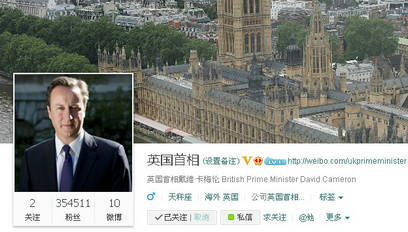When British Prime Minister David Cameron returns home from his carefully choreographed trip to China, he will be surprised by the dozens of business contracts that will start to flow in, as well as by endless questions from thousands of his new Chinese friends on social media.

I have long observed foreign politicians trying to engage with Chinese fans, sometimes in the millions, through social media. Their teams waste no time uploading their schedules, speeches and short ideas in English, French or other languages.
However, these messages usually fail to reach the Chinese public, mainly because they are not written in Chinese.
So I have drawn the impolite conclusion that most efforts by foreign politicians and their handlers to involve ordinary Chinese via social media have been pretty much failures.
But Cameron's team has made a difference. It set up a micro blog for the prime minister on Sina Weibo. Cameron is a latecomer, but for the prime minister it has been a case of better late than never.
By Wednesday, Cameron had uploaded seven posts, even though he only started to use the tool on Friday. Of the seven, three were posted as warm-up messages before he began his China tour.
Cameron has used the Chinese language in all of his posts, and two are bilingual. this marks a huge difference from the posts of other global political figures in the past.
In terms of content, Cameron's posts are all simple and original, and accompanied by photos. They are not mere recaps of official documents, schedules and speeches.
Not shy of advertising, Cameron has even managed to publish two posts about Land Rover in a short time, in an effort to help market the car brand to China's new rich.
The most interesting part of Cameron's excursion into Chinese social media is his team's ambition to set up a dialogue between the prime minister and the public. In one recent post, Cameron asked his followers to leave questions for him, saying he would answer some of them before he left China.
The number of Cameron's micro blog followers surpassed 260,000 in one week, roughly equal to the number of subscribers to two of his country's newspapers, The Guardian and The Financial Times.
Cameron does not have the largest number of followers among the dozens of foreign politicians in China's social media community. European Council President Herman Van Rompuy, who opened a weibo account in 2011, has more than 3 million followers.
Christine Lagarde, managing director of the International Monetary Fund, has been working to expand her network in China and has accumulated more than 3.5 million followers. To my surprise, this Frenchwoman uses French and English most of the time.
Christiana Figueres, climate change chief of the United Nations, also has opened a weibo account that now has more than 45,000 followers, a relatively small number compared to the others. But she and her communications team have almost no experience in using the Chinese language on micro blogs, particularly when discussing this complex topic.
Though Cameron has not responded to the mounting comments on his weibo account so far, he should be delighted by the responses from his followers, who can understand his messages in Chinese. His latest post has been forwarded and commented upon more than 20,000 times.
Van Rompuy had no such luck during his November visit to Beijing. His team published several posts related to his official meetings with Chinese leaders, but each attracted fewer than a dozen comments.
More recently, Van Rompuy made some progress by posting several short notices and comments in Chinese. But the number of responses was still small, given his colossal number of fans.
Van Rompuy welcomed Cameron to blogging in China on Tuesday in his latest post, expressing the wish that the British leader follow suit in making Chinese friends who are truly interested in building closer EU-China relations through social media.
Van Rompuy is correct to encourage European leaders to invest time and energy. But in practice, he and other politicians should follow Cameron's example. While blogging in China is open, fast and interactive in China, it shares features with traditional media content.
The politicians should bear in mind that content is king in social media, just as it is in journalism. It is the key to expanding a social media network and attracting a bigger audience.
Furthermore, using netizens' own language shows respect. It would be useful if foreign political figures followed Cameron and studied his team's efforts to carry on effective conversations with Chinese followers.
相关内容
我早就观察到外国政客试图通过社交媒体接触数以百万计的中国粉丝。他们的团队抓紧时间用英语、法语或者其他语言上传政客的日程、言论和想法。
但是,中国的民众通常看不到这些信息,主要原因在于它们都不是用中文写的。
所以我得出一个有点失礼的结论,那就是外国政客及其团队通过社交媒体接触中国大众的努力全都是白费。
但是,卡梅伦的团队明显与众不同。他们为首相开通了新浪微博。卡梅伦是迟到者,但是对于首相来说,迟到总比不到要好。
虽然卡梅伦11月29日才开始使用微博,但是,截至12月4日,他已经发表了7条帖子。这7条中有三条是在他开始中国之行前发布的热身信息。
在他所有的帖子里,卡梅伦都用了中文,有两条是双语的。这与以前其他外国政客的帖子有明显不同。
从内容上来讲,卡梅伦的帖子都很简洁,具有原创性,还添加了图片。这些帖子并不只是官方文件、日程和言论的翻版。
卡梅伦从不羞于做广告,他甚至在短期之内发了两条关于路虎的帖子,希望能够帮助这个汽车品牌进入中国新富市场。
卡梅伦中国社交媒体之行的最有趣之处就是,他的团队期望在首相和中国大众之间开展对话。在最近的一条帖子当中,卡梅伦请粉丝们为他留下问题,并承诺在他离开中国之前他会回答部分问题。
在一周之内,卡梅伦的微博粉丝突破26万,这差不多相当于英国《卫报》和《金融时报》订阅者的数量之和。
在众多使用中国社交媒体的外国政客当中,卡梅伦并不是粉丝数量最多的一个。欧洲理事会主席范龙佩于2011年开通微博,已有300万余粉丝。
国际货币基金组织总裁克里斯蒂娜·拉加德在中国扩展社交网络,拥有超过350万粉丝。令我吃惊的是,这位法国女性大多数时间使用法语和英语。
《联合国气候变化框架公约》秘书处执行秘书克里斯蒂娜·菲格雷斯也开通了微博,拥有4.5万粉丝,与其他政客相比较少。但是,她和她的团队几乎没有在微博上使用中文的经验,尤其是在讨论气候这个复杂话题的时候。
尽管卡梅伦到目前为止还没有对微博上如山的评论进行回复,但是那些能够读懂他中文微博的粉丝们所发来的回复肯定会令他非常开心。他最近的一条帖子被转发和评论2万余次。
11月来访北京的范龙佩就没那么幸运了。他的团队发表了几条有关他与中国领袖官方会晤的帖子,但是每条帖子只有几条评论。
最近,范龙佩用中文发表了几条状态和评论。但是与他数量庞大的粉丝相比,回复的数量仍然很少。
12月3日,范龙佩在最近的帖子中欢迎卡梅伦开通微博,他希望卡梅伦也像他一样,与真正期望通过社交媒体进一步密切中国-欧盟关系的中国人做朋友。
范龙佩鼓励欧洲领导人在这方面花费时间和精力的举动是正确的。但是在实践方面,他和其他政客应该像卡梅伦学习。尽管在中国微博具有开放性、快捷性和互动性的特征,但是它也与传统媒体有相同的特征。
与新闻业一样,在社交媒体中,内容至上。这一点政客们应铭记于心。这是拓宽社交媒体网络和吸引粉丝的关键。
此外,使用网民的母语是表达尊重的一种方式。如果外国政客仿效卡梅伦及其团队与中国粉丝进行有效对话,将会收到明显成效







